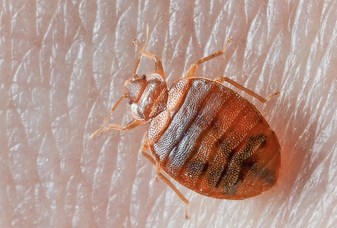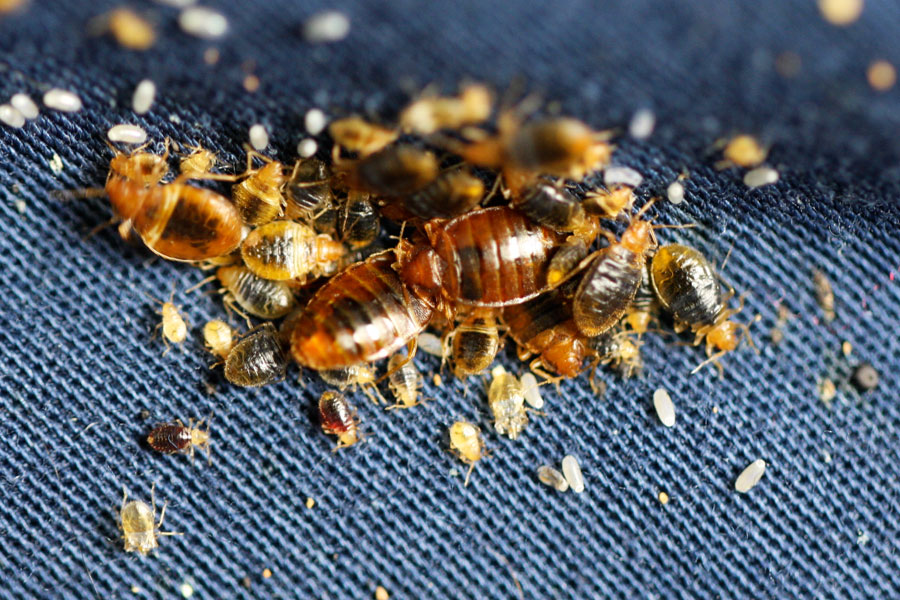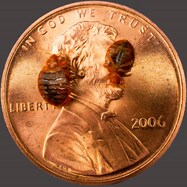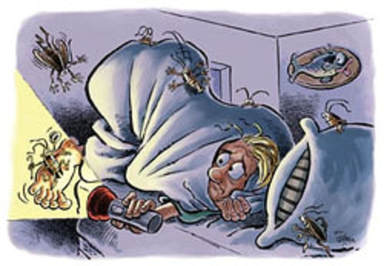bed bug life cycle
Introduction
Scientific Family: Climex lectularius Linnaeus
Scientific Family: Climex lectularius Linnaeus
|
What is a Bed Bug?
The common bed bug is a small, six legged, mahogany to rusty brown colored insect. They are wingless, flat and oval shaped and become swollen and elongated after eating a blood meal. They are tiny, only about 1/4 inch long as adults. Although they don't jump or fly, they are fast runners. They tend to congregate together in groups and are easy to see with the naked eye, but difficult to find due to their hiding elusiveness. Their biology is such that it naturally promotes infestation and they have the capacity to re-infest a room in as little as three months. |
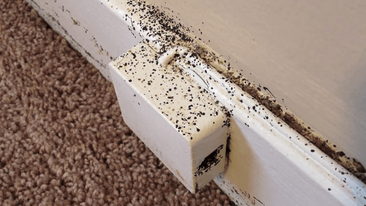
How do Bed Bugs Feed?
As indoor nocturnal pests, they prefer to feed off of human hosts but will feed on other warm blooded mammals when desperate or during a severe infestation. As a survival instinct, bed bugs are elusive. They know to stay out of view during the daytime, hiding in mattress crevices, box springs, baseboards, behind electrical switch plates, in picture frames, and even behind wallpaper. But at night time, the carbon dioxide we exhale often tempts them out of their hiding spots. Attracted to body heat and carbon dioxide (but not odors), they will typically find harborage within four to eight feet of their food source (us) and because they are generally more horizontally mobile than vertical, they will look for hiding places at same level as their food source if possible. Bed bugs usually require 5-10 minutes to engorge themselves with blood. They feed by inserting two hollow, beak-like feeding tubes into their host. The first tube injects the bug's saliva, which contains anesthetics to numb the feeding area. The second tube draws blood. After feeding, they move to secluded places and hide for 5-10 days. During this time, they do not feed but instead digest their meal, mate and lay eggs.
As indoor nocturnal pests, they prefer to feed off of human hosts but will feed on other warm blooded mammals when desperate or during a severe infestation. As a survival instinct, bed bugs are elusive. They know to stay out of view during the daytime, hiding in mattress crevices, box springs, baseboards, behind electrical switch plates, in picture frames, and even behind wallpaper. But at night time, the carbon dioxide we exhale often tempts them out of their hiding spots. Attracted to body heat and carbon dioxide (but not odors), they will typically find harborage within four to eight feet of their food source (us) and because they are generally more horizontally mobile than vertical, they will look for hiding places at same level as their food source if possible. Bed bugs usually require 5-10 minutes to engorge themselves with blood. They feed by inserting two hollow, beak-like feeding tubes into their host. The first tube injects the bug's saliva, which contains anesthetics to numb the feeding area. The second tube draws blood. After feeding, they move to secluded places and hide for 5-10 days. During this time, they do not feed but instead digest their meal, mate and lay eggs.
|
Bed Bug Reproduction & Life Cycle Eggs: A Bed Bug's life begins with an egg, each tiny in size (about 1mm long) and milky white in color. They are laid in clusters of one to 50 inside cracks (such as bed seems) or rough surfaces using “cement” produced by the females. They reproduce remarkably fast, each female has the capacity of laying 200-500 eggs during their 10-12 month lifespan. Since they are indoor pests, they can reproduce all year long with the proper temperature and food supply. According to bedbugs.org, eggs take between 6 and 17 days to hatch. Exponential population growth can occur very quickly if we do not take action to eradicate them. |
Nymphs: Newly hatched bed bug nymphs are clear and virtually invisible to the naked eye. They begin to feed immediately upon birth and will grow to full adulthood in 21-37 days, through a series of five stages of development, called an instar, before they reach adult maturity. These six life stages will see a one molt each (ecdysis), shedding their skins and discarding their outer shells which are clear, empty exoskeletons of the bugs themselves. With each molt, the bed bug grows larger and darker in appearance with a blood meal required for each molt to occur and for the bed bug to advance in development on route to adulthood.
|
Adults: Upon reaching maturity, bed bed adults will have consumed five blood meals and are now apple seed in size (5-7mm or about 1/4" long). EPA.gov tells us they are now long and brown in appearance and balloon-like if recently fed. At this point, they typically continue to feed weekly and after each meal, they will retreat back into hiding to digest, seek a mate or rest. As adults, they are capable of running very quickly on horizontal surfaces and vertical crawling is possible but more difficult. They do no jump fly but are now proficient at latching onto our luggage, purses and clothes. With an adequate food supply, they can live for more than 300 days and an adult bed bug can survive up to one year without a blood meal by hibernating. During it's lifespan, one adult male can father five generations creating hundreds of bed bugs that willing and able to interbreed with each other on route to assimilating you in to their Bed Bug Collective!
|
As a family run local business, it is our sole mission to provide you an antidote to the extreme cost of professional bed bug extermination through 100% effective and chemical-free DIY heat treatment equipment rentals.


